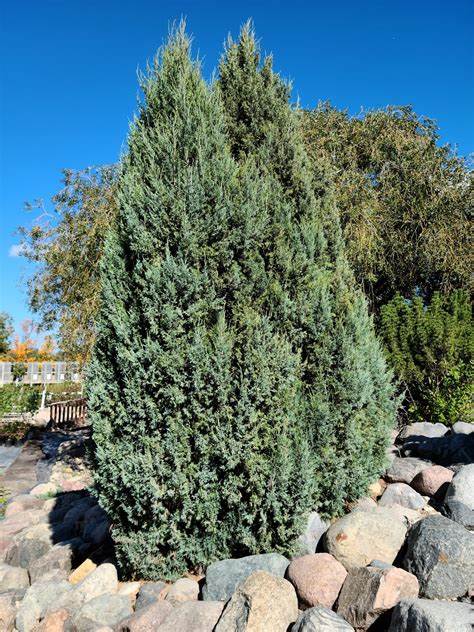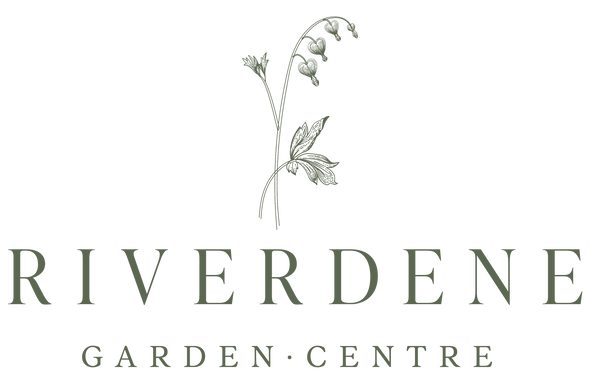Riverdene Garden Center
Medora Juniper
Medora Juniper
Couldn't load pickup availability
Juniperus scopulorum ‘Medora’
Medora Juniper is a narrow, upright, slow-growing evergreen with dense, blue-green foliage. It is a cold-hardy (Zone 3), drought-tolerant, and low-maintenance tree, making it an excellent choice for windbreaks, privacy screens, vertical accents, and small yards in Southwest Saskatchewan. Unlike other columnar junipers, Medora has a more compact, refined growth habit, making it less prone to winter damage.
Planting & Location
- Hardiness Zone: 3-7 (excellent for cold prairie winters)
- Mature Size: 10-15 feet tall, 3-4 feet wide
- Growth Rate: Slow (6-12 inches per year)
- Sunlight Needs: Full sun (at least 6 hours of direct sunlight per day)
-
Soil Preference:
- Prefers well-drained, sandy or loamy soil.
- Tolerates poor, rocky, and alkaline soils.
- Avoid heavy clay or waterlogged soil—prone to root rot in wet conditions.
-
Spacing:
- 3-4 feet apart for a dense screen or hedge.
- 5-6 feet apart for individual plantings.
Watering
- Young Trees (First 2-3 Years): Water deeply once per week to establish roots.
- Established Trees: Drought-tolerant; water every 2-3 weeks in dry periods.
- Avoid Overwatering: Prefers dry to medium moisture levels—too much water can cause root rot.
Fertilizing
- First Year: No fertilizer needed—focus on root establishment.
-
Mature Trees:
- Apply a slow-release evergreen fertilizer (e.g., 10-10-10) in early spring if needed.
- Organic alternative: Compost or well-rotted manure in spring.
Pruning & Maintenance
- Minimal pruning required—naturally maintains a narrow, upright shape.
- Best Time to Prune: Late winter to early spring, before new growth starts.
-
How to Prune:
- Remove dead, diseased, or broken branches.
- Light trimming can enhance density but avoid heavy pruning.
- Do not cut into old wood—junipers do not regenerate from bare branches.
Pest & Disease Management
Common Pests:
-
Spider Mites – Can cause browning needles.
- Solution: Hose off with water or use insecticidal soap.
-
Juniper Scale – Small, white, waxy insects on needles.
- Solution: Treat with horticultural oil or insecticidal soap.
-
Bagworms – Caterpillars that create cone-shaped silk bags.
- Solution: Remove by hand or use Bacillus thuringiensis (Bt) spray.
Common Diseases:
-
Cedar-Apple Rust (Gymnosporangium spp.) – Orange, jelly-like galls in spring.
- Solution: Remove infected branches and avoid planting near apple trees.
-
Root Rot (Phytophthora, Armillaria) – Can occur in poorly drained soil.
- Solution: Ensure well-draining soil and avoid overwatering.
Winter Protection
- Highly winter-hardy but may experience winter burn in exposed locations.
- Mulching: Apply 2-4 inches of mulch around the base (not touching the trunk) to insulate roots.
- Wind Protection: In very harsh winters, consider burlap wrapping to prevent desiccation.
Landscape Uses
Perfect for narrow spaces and small yards
Great vertical accent or screening tree
Low-maintenance and drought-tolerant
Cold-hardy and withstands harsh prairie winters
Deer-resistant and urban pollution-tolerant
Additional Notes:
- Medora Juniper is one of the best columnar junipers for cold, dry climates due to its dense foliage and resilience.
- Lifespan: 50+ years with proper care.
- Works well in rock gardens, windbreaks, mixed borders, and modern landscapes.
Photo courtesy of Falk Nurseries
Share


